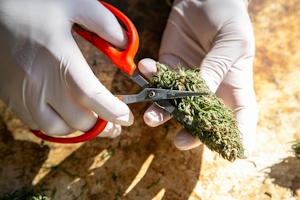
5 Biggest Cannabis Cloning Mistakes & How To Avoid Them
Learn how to keep clones alive by avoiding these five cloning mistakes.
Breeding healthy, thriving cannabis clones is easy.
But, a few rookie mistakes can leave you with a sad, droopy cutting that never makes it to harvest.
Keep reading to learn more about cloning marijuana plants and the five biggest mistakes to avoid when keeping clones alive.
What Is Cloning Weed?
If you’ve ever stumbled across a cannabis plant that feels like it was practically designed for you—perfect aroma, smooth high, no weird surprises—cloning is how growers keep that magic alive.
Cannabis cloning involves using a cutting (aka a “clone”) from a healthy plant and placing it in water, then soil, to form roots. The new plant is genetically identical to the original.
Why clone instead of starting from seeds? Seeds are unpredictable. They don’t always turn out the same every time, and can have quite a bit of variety. Cloning, on the other hand, is reliable. It guarantees you’ll get the same quality and effects you know and love.
Plus, clones skip the early seedling stage, which means less waiting around for your plants to get their act together.
It may sound easy, but there are some mistakes cultivators often make when cannabis cloning. See below for the most common cloning mistakes and how to avoid them.
5 Top Mistakes When Cloning Cannabis
Lighting
Growers often like to keep their plants under a constant 24 hours of light. However, when rooting clones, this constant light is unnecessary.
Instead, most growers opt for 18 hours of light and six hours of darkness. Anything extra adds additional cost to your electric bill and risks stressing the plants out.
A high-intensity light is not needed for clones. Opt for cool light that is placed far enough away from the cuttings to avoid heat stress. At this point in the cloning process, plants are delicate, and any additional stress may impact the viability of the cuttings.
Humidity & Temperature
Young clones like hot and humid environments. Humidity domes are used to maintain the optimum conditions for plants to begin rooting. Humidity domes trap evaporating moisture and help maintain a constant temperature for your plants.
When using a humidity dome, several major problems can occur. First, while new cuttings love hot and humid environments, so do molds, fungi, and pathogens. For this reason, ventilation is necessary.
Small holes in the dome cover allow for increased oxygen and airflow into the dome, reducing the chances of mold and infection. Opt for 80% humidity at first. Young clones don’t need 100% humidity to root effectively.
Minor ventilation in a humidity dome serves another purpose: temperature control. Roots, which are naturally cooled underground and shaded from the sun, thrive in temperatures of 75 to 80℉ (24-27℃), while canopy temperatures often run hotter, up to 85℉ (29℃).
While your clones are rooting, checking the temperature regularly and adjusting ventilation as needed is best practice. Adjusting the proximity of your lighting source and increasing or decreasing ventilation is helpful for maintaining the proper temperature conditions for delicate plants.
Cut At A 45° Angle
Clones are sensitive. When taking your cuttings, use a very sharp pair of pruning shears and cut the stem at a 45° angle.
Cutting at an angle rather than straight across creates a greater surface area, which allows for greater uptake of your rooting hormone, cloning nutrient solution, and water.
Furthermore, it protects the original plant by letting rain and moisture slide off the cut rather than sitting on a flat surface and increasing the risk of mold.
Place In Water Immediately
Don’t delay! Waiting too long to place your cuttings in water is one of the biggest weed cloning mistakes you can make.
Place the stem of your cuttings in water immediately after cutting. If cuttings are not placed directly into a bowl of water, an air bubble may form in the stem.
Air bubble formation not only blocks the uptake of water but will prevent your plant from properly forming roots. Once it forms a healthy root system, you can transplant it into your growing medium.
Cleanliness
Cleanliness is one of the most underrated aspects of cutting and preparing clones. Since clones root best in warm, damp environments, pathogenic infections can easily devastate your nascent cuttings.
Help keep your clones alive with these cleanliness tips:
- Sterilize your work surface before cutting and preparing your clones.
- Wash your humidity dome with warm soapy water.
- Wash scissors or pruning shears before taking your cutting.
- Keep compost, other plants, and general debris away from new cuttings.
- Place cuttings in a water bowl that has been washed with warm, soapy water.
Of course, allow all of your clean materials to dry before use. Make sure to rinse materials thoroughly to ensure that no soap residue remains before cloning.
Herb Recommended Products:
READ MORE










